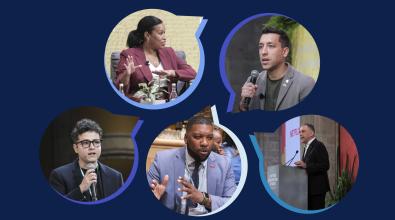The right way to cut a budget
You don’t have to like austerity to embrace it. The key is to involve residents in the process.

(Shutterstock/Elena Abrazhevich)
In 2012, Peter Moore was given an unpleasant task nobody working in local government wants. At the time, he ran social services in Sefton, a city of 275,000 in the U.K. near Liverpool. The city could no longer afford to provide its community meals service, which brought daily hot meals to about 350 vulnerable, mainly elderly people. It cost the city about $300,000 per year to administer. The local council asked Moore to cut that cost to zero.
Many families in Sefton were already facing really hard times. Sefton used to be a rich city with a big industrial port, much like Hamburg, where I am from. At the heart of a thriving community were the docks, where fathers and sons had worked side-by-side for decades. But then, starting in the 1970s, the port declined, jobs disappeared, and Sefton never recovered. When Prime Minister David Cameron promised austerity in 2010 and slashed aid to local councils, it meant Sefton would have to cut about half the city budget, or roughly $300 million. Community meals were just one of many services on the line.
I don’t envy Moore for being assigned this job. Sefton already could not keep up with growing child poverty, worsening health, and rising unemployment. Many families had to choose between buying food or heating their homes in winter. But the way Moore approached it represented something of a breakthrough—and it’s a model with takeaways for today’s local leaders as they face budgets ravaged by the pandemic.
Here’s how Sefton’s community meals worked. People who needed meals had to pay $5 per meal to the city. The city paid an additional $3 per-meal subsidy through a $300,000 agreement with a food company to provide those meals. Under less dire circumstances, Moore might have started by asking whether it was possible to raise the per-meal price to residents just a bit, or trim the food-service contract. But those weren’t options. Instead, he decided to start with a more basic question: What is that that people using this program really need?
So he went out, met them in their homes, and talked with them—not just about meals but about their needs more broadly. One thing he learned quickly was that nobody much liked the food they were getting through the program. Another thing he learned by talking to users was that they were lonely. For many, that meal delivery was the only human contact they had each day, and they were afraid of losing it. In other words, community meals were about more than providing food.
To tackle the loneliness issue, Moore partnered with Age Concern, a voluntary organization that facilitated the interviews. The group coordinated volunteers to visit the users of community meals, to listen to their specific needs, and connect them with activities in the city like cycling or walking groups, social services, or help with managing money.
To address food deliveries, Moore and his team engaged the help of local food businesses, 40 of which agreed to provide hot meals at no cost to the city and at the same $5 out-of-pocket cost to residents. That also allowed people to select meals from 40 menus instead of getting the same old meal every day. By the time Moore was done, he had not only saved Sefton the $300,000 but also found better ways to meet his residents’ needs.
Paul Cummins, a city councillor in Sefton, was Moore’s superior at the time and the political leader responsible for social services. To find millions more in budget savings, Cummins applied the same tactics of involving residents at every step and empowering them to find creative solutions.
For example, when the city had to cut 20 percent from the budget of a program that provides cooking, cleaning, and shopping support to people with special needs, they brought both service providers and users into the process. They worked together to not only cut spending but also to create a shared vision of how to save money while maintaining residents’ independence. Sefton also groomed local nonprofits to bid against corporate service providers the city had used in the past, in order to have more affordable options based right in the community.
"By choosing to involve the community in difficult decisions, city halls can share the burden of services while creating a powerful political narrative of local strength."
I asked Cummins what this intense period felt like to him. His party, the Labour Party, took over Sefton City Council in 2012. Politically, they were opposed to the central government’s austerity campaign, which had painted local governments like Sefton’s as lazy and wasteful. It was a political nightmare—and a moral nightmare, because so many people were suffering.
Frustration turned into a mission: Sefton’s leaders would invest themselves in making the best of a situation they could not control. They would give up the old patriarchal way of doing budget cuts, where public leaders sit down and decide on their own what to cut. Instead, they would be transparent about hard realities and involve the public in implementing the cuts. Cummins says none of it would have been possible without volunteer organizations that were close to and understood the people who needed support.
Over time, this changed the way the whole government worked. And it worked politically, too: Despite cutting so many services, Cummins and his Labor colleagues won the next local election.
As city halls everywhere face budget cuts in these lean times, Sefton provides at least three valuable lessons. The first is to accept changing realities quickly. Sefton leaders showed humility early on, knowing that a top-down approach to running government would no longer be viable. By choosing to involve the community in difficult decisions, city halls can share the burden of services while creating a powerful political narrative of local strength.
The second lesson is to protect exceptional public servants, like Moore, from becoming demoralized. Their creativity and moral compass is critical to maintaining service levels, and as Moore told me, it’s exhausting work. Their efforts need to be recognized, both to boost them and inspire others.
Finally, instead of working with big outside companies that promise to be fast and cheap, cities should think more carefully about who they contract with. If the key to getting through hard times is listening and learning from people, then cities should have partners who do just that. Leaders should work with organizations and businesses who share their values and care for the community.
Sascha Haselmayer is a social entrepreneur and Fellow in the New America Public Interest Technology Group and has worked with more than 100 city governments in North America, Latin America, Asia, and Europe to realize their more inclusive urban, social, and procurement innovation projects.

